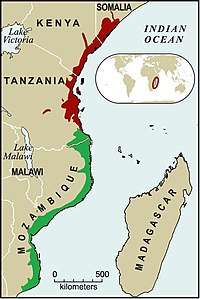Southern Zanzibar-Inhambane coastal forest mosaic
The Southern Zanzibar-Inhambane coastal forest mosaic, also known as the Southern Swahili coastal forests and woodlands,[1] is a tropical moist broadleaf forest ecoregion of eastern Africa. It is a southern variation of Northern Zanzibar-Inhambane coastal forest mosaic. The ecoregion supports habitats of forest, savanna and swamps. The southern portion of the ecoregion is not as well studied due to the 1977-1992 civil war in Mozambique.
| Southern Zanzibar-Inhambane coastal forest mosaic | |
|---|---|
 Northern Zanzibar-Inhambane coastal forest mosaic
Southern Zanzibar-Inhambane coastal forest mosaic | |
| Ecology | |
| Realm | Afrotropic |
| Biome | Tropical and subtropical moist broadleaf forests |
| Geography | |
| Area | 144,800 km2 (55,900 sq mi) |
| Countries | Mozambique, Tanzania |
| Conservation | |
| Conservation status | critical/endangered |
| Global 200 | Coastal forests of eastern Africa |
Setting and limits
The ecoregion extends along the coast of Tanzania and Mozambique, from Tanzania's Lukuledi River south almost the whole way to the mouth of the Limpopo River.
It is mostly coastal, generally within 50 km of the Indian Ocean. It encompasses coastal lowlands, rolling hills, and isolated plateaus and inselbergs, including the Rondo and Makonde plateaus in southern Tanzania, the Mueda Plateau in northern Mozambique.[2]
It includes some isolated mountainous enclaves further inland, including Mount Chiperone, Mount Mabu, Mount Morrumbala, Mount Namuli, and Mount Tumbine in northern Mozambique, and the southeastern slopes of the Eastern Highlands, including Moribane forest. The mountains intercept humid southwesterly winds from the Indian Ocean, which form clouds and rain and create a cooler, wetter climate than the surrounding lowlands. These mountains are home to lowland evergreen forests with a similar flora to the coastal lowland forests, and higher-elevation montane forests, woodlands, grasslands, and heathlands which are home to many Afromontane species.[3] The WWF scheme follows Frank White's 1983 "Vegetation Map of Africa" by including these inland mountains in the coastal forest mosaic ecoregion. Other researchers, including Jonathan Timberlake of Kew Gardens, maintain that the flora and fauna of Northern Mozambique's interior inselbergs, especially at higher elevations, have greater affinity with the Afromontane Eastern Arc forests.[4][5]
The ecoregion is bounded on the east by the Indian Ocean. To the north, it abuts the Northern Zanzibar-Inhambane coastal forest mosaic. It transitions to drier open woodlands to the west – the Eastern Miombo woodlands at the northern end, the Zambezian and Mopane woodlands in the central portion, and the Southern Miombo woodlands at the southern end. To the south, it borders the Maputaland coastal forest mosaic. It also includes some small offshore islands in Mozambique, including the Quirimbas Islands and Bazarruto Archipelago.
Climate
The climate is tropical in the northern portion, becoming sub-tropical at the southern end. In the area around Lindi in Tanzania there is one long dry season and one wet season. Rainfall is 800–1000 mm per year, and is higher on some of the plateaus and mountains. The climate is similar in the Mozambican portion, although rainfall is lower (800 mm) in northern Mozambique, which is in the rain shadow of Madagascar. Mean maximum temperatures are 30-27 °C in the north and 24 °C in the south, and mean minimum temperature is 18-15 °C throughout the ecoregion.[6]
Protected areas
Protected areas within the ecoregion include:
- Rondo Forest Reserve, Tanzania
- Bazaruto National Park, Mozambique
- Caça do Gilé wildlife reserve (part), Mozambique
- Gorongosa National Park (part), Mozambique
- Moribane Forest Reserve, Mozambique
- Pomene National Reserve, Mozambique
- Quirimbas National Park, Mozambique
See also
References
- Eric Dinerstein, David Olson, et al. (2017). An Ecoregion-Based Approach to Protecting Half the Terrestrial Realm, BioScience, Volume 67, Issue 6, June 2017, Pages 534–545, https://doi.org/10.1093/biosci/bix014
- Burgess, Neil, Jennifer D’Amico Hales, Emma Underwood (2004). Terrestrial Ecoregions of Africa and Madagascar: A Conservation Assessment. Island Press, Washington DC.
- "Southern Zanzibar-Inhambane Coastal Forest Mosaic". Worldwide Fund for Nature. Accessed 24 June 2018.
- Timberlake, J.R., Dowsett-Lemaire, F., Bayliss, J., Alves T., Baena, S., Bento, C., Cook, K., Francisco, J., Harris, T., Smith, P. & de Sousa, C. (2009). Mt Namuli, Mozambique: Biodiversity and Conservation. Report produced under the Darwin Initiative Award 15/036. Royal Botanic Gardens, Kew, London. 114 p.
- Conradie W, Bittencourt-Silva GB, Engelbrecht HM, Loader SP, Menegon M, Nanvonamuquitxo C, Scott M, Tolley KA (2016) "Exploration into the hidden world of Mozambique’s sky island forests: new discoveries of reptiles and amphibians." Zoosystematics and Evolution 92(2): 163-180.
- "Southern Zanzibar-Inhambane Coastal Forest Mosaic". Worldwide Fund for Nature. Accessed 24 June 2018.